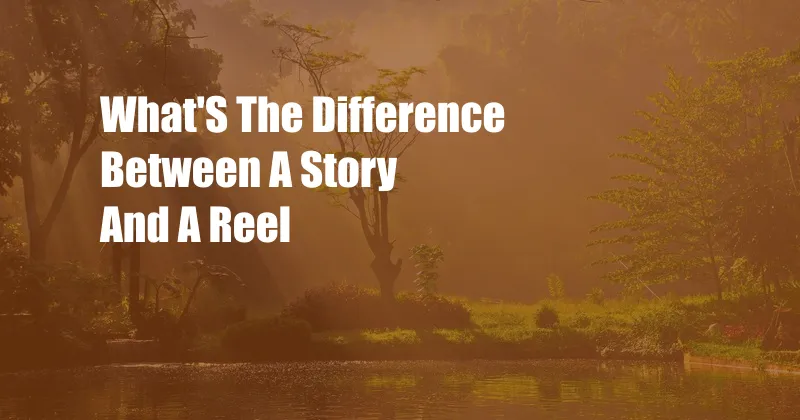
Stories vs. Reels: Unraveling the Differences and Making a Mark
Have you ever wondered about the intriguing world of digital storytelling? In today’s ever-evolving social media landscape, we’re constantly bombarded with two prominent formats: stories and reels. While both aim to capture our attention and convey messages, their approaches and impact differ significantly.
Stories: Ephemeral Moments, Personal Connections
Stories, popularized by platforms like Snapchat and Instagram, offer a glimpse into our fleeting moments and everyday experiences. They consist of a series of photos, videos, or text that disappear after 24 hours. This ephemeral nature fosters a sense of urgency and encourages viewers to engage promptly. Stories are perfect for sharing quick updates, behind-the-scenes glimpses, or connecting with followers on a more personal level.
Reels: Short-Form Videos, Entertainment Galore
Reels, on the other hand, are short-form videos with a maximum duration of 60 seconds. They’re designed to be captivating and often showcase visually striking content. Reels can include music, effects, and text overlays, making them a creative and entertaining way to engage audiences. Whether it’s dance performances, cooking tutorials, or travelogues, reels offer a platform for showcasing talents, sharing laughter, and spreading joy.
The Distinctions: Unveiling the Differences
Format: While stories are typically vertical and full-screen, reels can be both vertical and square. This format difference reflects their intended uses: stories for ephemeral personal updates, and reels for shareable, entertaining content.
Duration: Stories last for 24 hours, while reels have a longer lifespan unless manually deleted. This difference in duration influences how creators approach content creation and audience engagement.
Engagement: Stories foster a sense of intimacy and conversation through replies and reactions. Reels, in contrast, prioritize virality and reach, with metrics such as views, likes, and comments measuring success.
Purpose: Stories are primarily used for personal updates, while reels are geared towards entertainment and brand promotion. However, creators often find creative ways to blend these purposes, using stories to promote upcoming reels or vice versa.
Trends: Stories emerged as a response to the need for real-time, authentic content, while reels gained popularity as a captivating alternative to traditional video formats. Both formats continue to evolve, with new features and capabilities being introduced regularly.
Tips and Expert Advice: Elevate Your Storytelling Game
For Stories:
- Prioritize authenticity and share glimpses of your genuine experiences.
- Use engaging captions to foster conversation and build connections.
- Make use of story highlights to showcase important or frequently asked questions (FAQs).
- Experiment with polls, stickers, and filters to enhance audience interaction.
For Reels:
- Craft visually appealing content that captures the viewer’s attention within seconds.
- Use trending music, effects, and hashtags to increase visibility.
- Consider cross-promoting reels on other platforms to expand your reach.
- Optimize your reels for mobile viewing, as the majority of viewers access them through smartphones.
FAQs: Demystifying Common Questions
Q: Can I post a reel as a story?
A: Yes, you can share your reels as stories on Instagram by selecting the “Share to Story” option.
Q: How do I find popular reels?
A: Explore the “Reels” tab on platforms like Instagram or TikTok, where you can discover trending and popular reels.
Q: Can I make money from stories or reels?
A: Creators can earn revenue through brand partnerships, affiliate marketing, or by running ads within their reels on certain platforms.
Conclusion: Embrace the Power of Storytelling
Stories and reels, each with their unique strengths and applications, continue to shape the way we communicate and connect online. Whether you’re seeking to foster personal connections, share entertaining content, or establish a brand presence, understanding the differences between these formats is crucial for maximizing your storytelling impact. Are you ready to unravel the world of stories and reels and make your mark on the digital landscape?